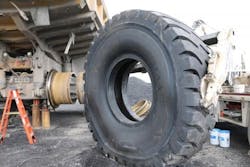Communication with an organization’s maintenance, operations, engineering, and project management departments enable fleet managers to stay on top of tire needs.
Project progression: As the project unfolds, hauls may go longer distances or heavier loads at higher speeds might be required to maintain scheduled production. With the project manager’s progress reports and forecasts for upcoming changes, managers can anticipate tire transport risks and lessen downtime by ensuring your machine is fitted with task-specific tires.
Surface threats: Site layout and surface conditions can contribute to tire wear and performance. Especially on projects where rough access roads are used for a long periods of time, being aware of steep haul road grades, ground type (gravel, mud, sand), unusual turns, speed restrictions, and unavoidable geographic hazards allows the matching of tires to the environment. Conditions with excessive heat, surface oils, hazardous materials, dump-site debris, or other rubber-eating hazards cause deterioration and lead to a shorter service life.
Human handling: Operators hold the day-to-day performance of off-road equipment tires in their hands and have a major influence on tire lifespan. Operations can work with fleet on operator training for specific job-site conditions and suggest guidelines to follow according to the task, equipment, and company standards. Also to consider are safety challenges that operators might experience on current live sites, as well as operator experience levels on specific machines and assignments.
Maintenance: A tire maintenance program should include the operator’s daily walk-around observations, weekly tire health evaluation reports, field incident reports, and up-to-date training for technicians charged with tire maintenance and repairs. Accurate information permits the monitoring of trends that have led to tire failures and downtime. Maintenance managers can track and compare unusual wear or repeated tire failures, which allows for correcting problems and matching the project manager’s forecasts.





